Welcome back to The Journey, where we follow hockey prospects and their paths to the NHL, providing fantasy predictions and analysis along the way. This week, we will highlight several small-bodied prospect defencemen with high offensive upside who may be getting overlooked in your league. Plus, we'll dig into the widespread idea that the emergence of Moritz Seider negatively impacted fellow Red Wings' stalwart Filip Hronek.
It looks as though Nils Lundkvist (NYR), just like Vitaly Kravtsov, Lias Andersson, and others before him, is unhappy with the lack of opportunity with the Rangers and is planning to not report to training camp this fall. A trade would likely do wonders for the 22-year-old defenceman's fantasy value, so that is a situation to monitor closely heading into the season.
Lundkvist is a smaller-bodied (5-10, 187lbs), offensive-minded powerplay specialist with excellent vision and four-way mobility. It was always going to be tough for him to excel in New York with Adam Fox sucking up all the powerplay time indefinitely and fellow young defenders like K'Andre Miller, Braden Schneider, and even Zac Jones all seemingly leapfrogging the young Swede for playing time.
It will be interesting to see what the trade market is like for a small, offensive defenceman like Lundkvist. This development reminded me of an interesting Twitter thread by Hockey Prospecting.com creator, Byron Bader from last month about how smaller offensive blue liners are one of the last remaining market inefficiencies in hockey:
That whole thread is worth a quick read. The short version is that bigger forwards and defencemen with middle- or bottom-six ceilings are generally still being drafted well ahead of smaller PP specialists who have more home run potential. If this trend slowly corrects itself in the coming years as the game continues to evolve in a direction friendly to shorter, slighter players, the value of drafted players who fit this mould should also increase. Here are a few worth highlighting.
Lane Hutson (MON)
Hutson, a product of the US Development Program, has received an incredible amount of post-draft scrutiny and praise since the Canadiens took him 62nd overall this year, so I won't dwell too long on him here. But Hutson is the poster boy for the market inefficiency Bader is referring to. He is 5-8, 159 lbs, scored 63 points in 60 games as a draft eligible, and finished the year with the third-highest star potential (60%) in his class—tied with Denton Mateychuk (CBJ) behind only Danila Yurov (MIN, 71%) and Simon Nemec (NJD, 62%).
At least according to Bader's HP model, which is based on historical comparables, Hutson is far more likely to reach stardom than fellow Hab and 2022 first overall pick, Juraj Slafkovsky. Let that sink in for a moment.
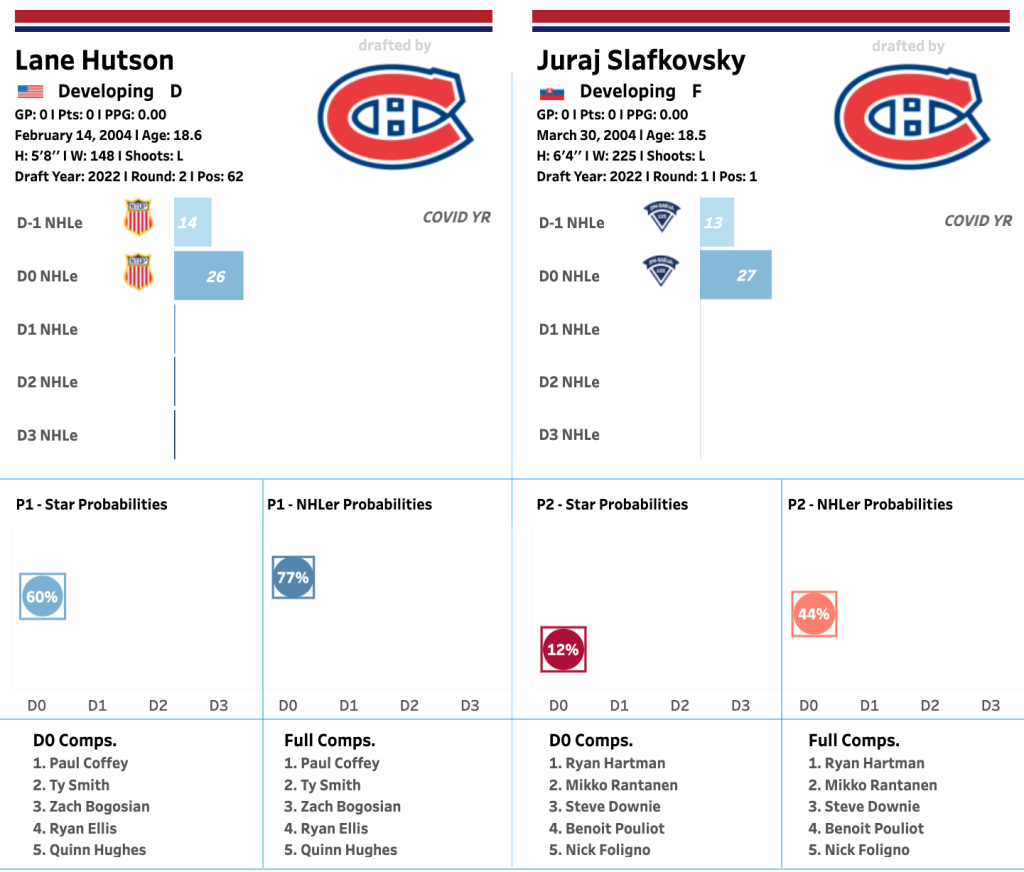
If you are interested in digging further into what makes Hutson so special, here are two excellent video threads by Dobber Prospects Associate Editor Hadi Kalakeche and DP writer Sebastian High:
Miguel Tourigny (MON)
Another dynamic but small-bodied Habs prospect, Tourigny is an incredible skater who transitions the puck efficiently and has an excellent shot. After every team passed over him in both 2020 and 2021, Montreal finally rolled the dice on his talent this year in the seventh round (216th overall).
His size plus his mediocre draft year production (30 points in 61 QMJHL games) explains why he was passed over the first time. But Tourigny then posted rates of 1.13 and 1.23 points per game the following two years, leaving him with a current star potential of 15% even as an overager—not bad at all for a seventh-round pick.
Of course, the reason teams have generally avoided smaller defencemen like Tourigny is that they tend to struggle on the defensive side of things once they are playing against bigger, faster NHL players. Indeed, these are the areas where Tourigny struggles and may represent the reason why he never makes the NHL.
Check out the statistical picture painted by QMJHL Scout Andy Lehoux:
Tourigny clearly has dynamic offensive skills. He led all Q defencemen last year—including higher profile players like Lukas Cormier (VGK) and Jeremie Poirier (CGY)—in Scoring and Transitions and finished second only to William Villenueve (TOR) in Playmaking.
But as you can see, his passing, puck battles, physicality, and overall defensive play are noticeable weaknesses. He will need to put in some serious work in these areas to put himself in a position to bring his offensive talents to the highest level. He is a player to watch over the next couple years as he transitions to pro hockey, but it is likely too early to add him outside of the deepest leagues.
Dominick Fensore (CAR)
Although Fensore (5-7, 150 lbs) is not as dynamic as Hutson, his draft year scoring rate of 0.76 with the USDP outstripped 2022-eligible Seamus Casey's (NJD) mark of 0.69 with the same program. This past year, in his third year of college hockey, Fensore scored 31 points in 35 games, playing a major role for the heavyweight Boston University and leading the entire team in scoring. He will return to BU in 2022-23 before making the jump to pro hockey.
Like the others, Fensore fell to the third round and has largely remained off fantasy radars because of his small size. Further, because he is considered "exceptionally sized," he will likely take 400 games to hit his Breakout Threshold and show his ultimate upside. But he is trending very well for a player who many poolies likely have never heard of.
Another prospect to monitor in points-only keeper and dynasty formats in particular. If he transitions well to pro hockey in 2023-24, that would be the time to stash him. Just be prepared for a long wait—perhaps comparable to Sens prospect Erik Brannstrom.
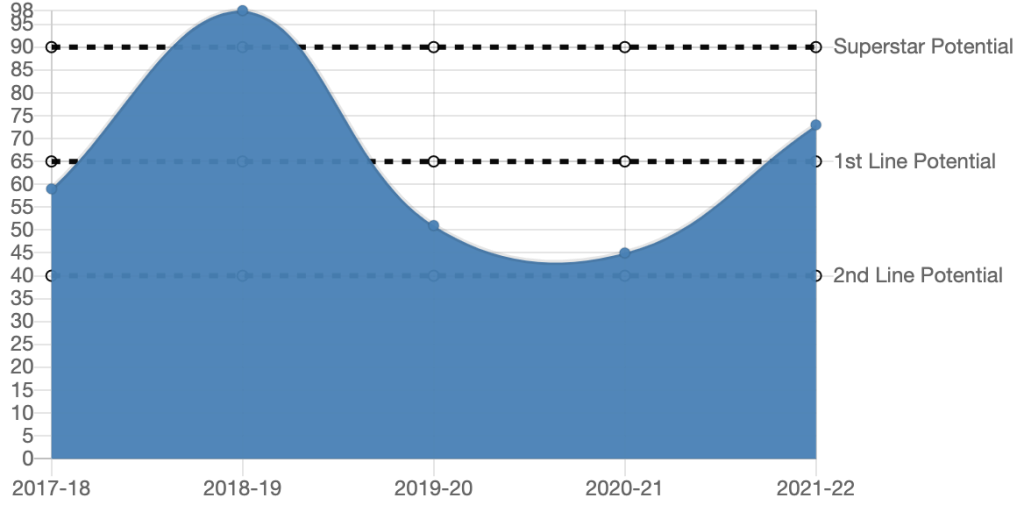
Filip Hronek (DET)
Switching from inefficiencies to myths for a momen, there is a widespread perception in fantasy that Hronek, 24, has declined as a fantasy asset given the dominance of Seider and the impending arrival of Simon Edvinsson and Albert Johansson. But did Seider's Calder-winning season actually have a negative impact on Hronek's production?
The short answer is no. Hronek co-existed relatively harmoniously with Seider in 2021-22 and will continue to be a staple in the top four of a rising Red Wings squad—even after Edvinsson and Johansson make the leap. In fact, he just passed his Breakout Threshold, partway through last year, and is a solid "buy low" player heading into 2022-23.
Here's why: for most of the three seasons before Seider arrived, Hronek was the go-to guy for the Wings both defensively and offensively. This past year with the German super-rookie in the fold, Hronek's power play share declined by about 13%, which knocked four points off his PPP total, and he received about a minute and a half less of average total ice time last year than the year before.
But with Seider (light blue bubble above) taking on other teams' top players, Hronek actually faced lower quality of competition in 2021-22 than in his previous three years. He also received slightly more offensive zone starts than Seider.
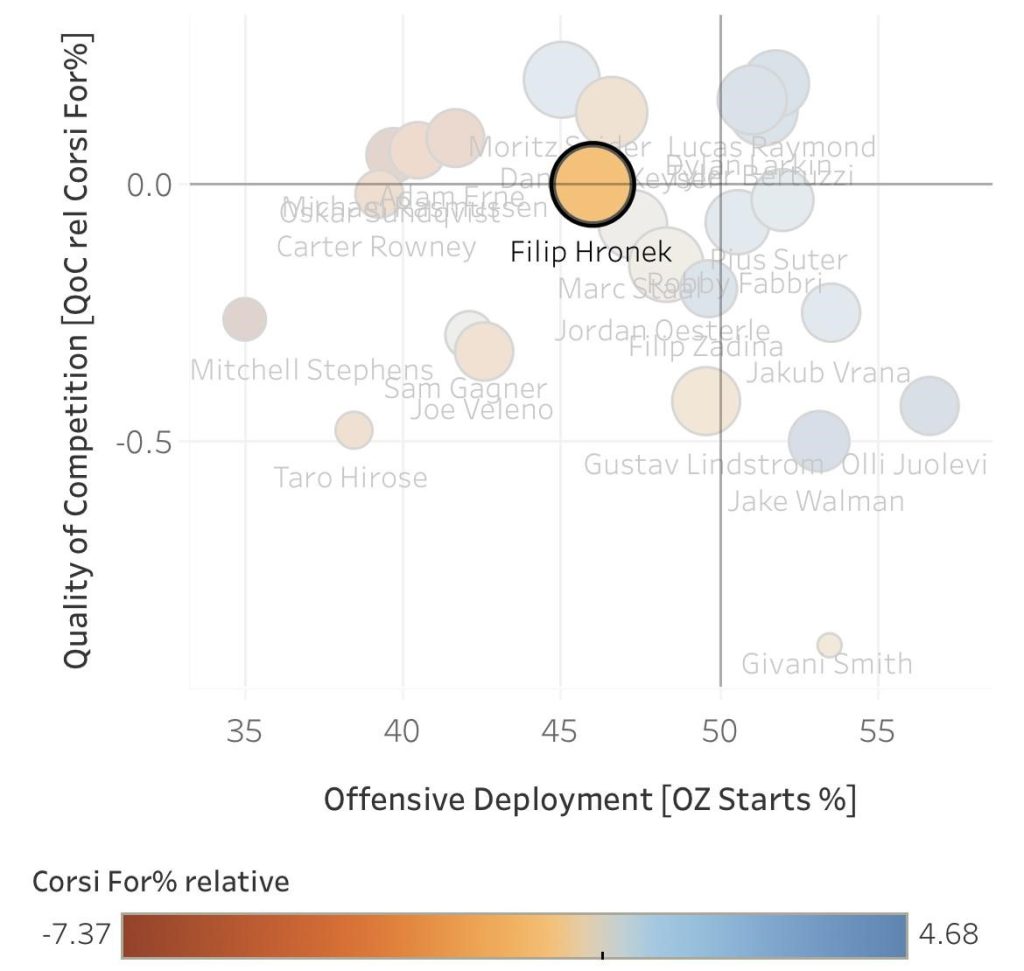
The end result was that Hronek posted numbers very much in line with what he produced over his previous three campaigns. Here are his 82-game point paces, starting with his rookie year: 41, 39, 38, 40. Incredibly, none of his counting stats have varied a lot either. In the same order, here are his power play points (5, 10, 11, 7), shots (1.59, 1.92, 2.04, 1.71), hits (1.43, 1.62, 1.2, 0.9), and blocks (0.7, 1.14, 0.82, 1.04).
Hronek is an above-average fantasy defenceman who will reliably bring in half a point, a couple shots, and a hit and block per game—seemingly regardless of who else is patrolling Detroit's blue line. If he breaks out in 2022-23 and sees the expected 25% bump in production, that thrusts him into 50-point territory with decent peripherals. Dobber has him at 43 points in the Fantasy Guide. Get your copy here.
Although Hronek is half a season past 200 games, the young defender's scoring actually declined from a 44-point pace to 35 after hitting his projected breakout, which is a bit mystifying. But as with 2016-17 Nathan MacKinnon and 2020-21 Nico Hischier, who were discussed a few weeks ago, however, Hronek's post-BT struggles may have less to do with him and more to do with the poor team around him.
Detroit came out of the gates strong last year, led by a point-per-game Lucas Raymond, the immediately intimidating Seider, and a rejuvenated Dylan Larkin. But they faltered down the stretch just as Hronek passed his BT. From Hronek's 200th to 245th game, the Wings won only 16 times, lost 30 times, and were outscored by 60 goals. It was just a tough slog for Detroit to end the 2021-22 season, and odds are that they will be more consistently successful this year—Hronek included.
Thanks for reading! Follow me on Twitter @beegare for more prospect content and fantasy hockey analysis.
—————–


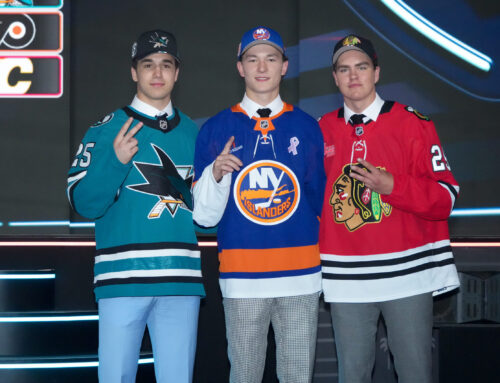
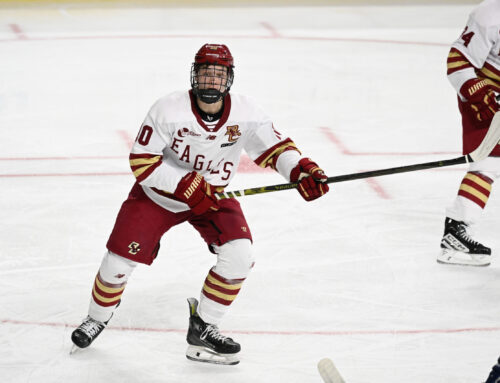
 FLA
FLA CHI
CHI NYR
NYR PIT
PIT L.A
L.A COL
COL MTL
MTL ANA
ANA STL
STL N.J
N.J VAN
VAN EDM
EDM
